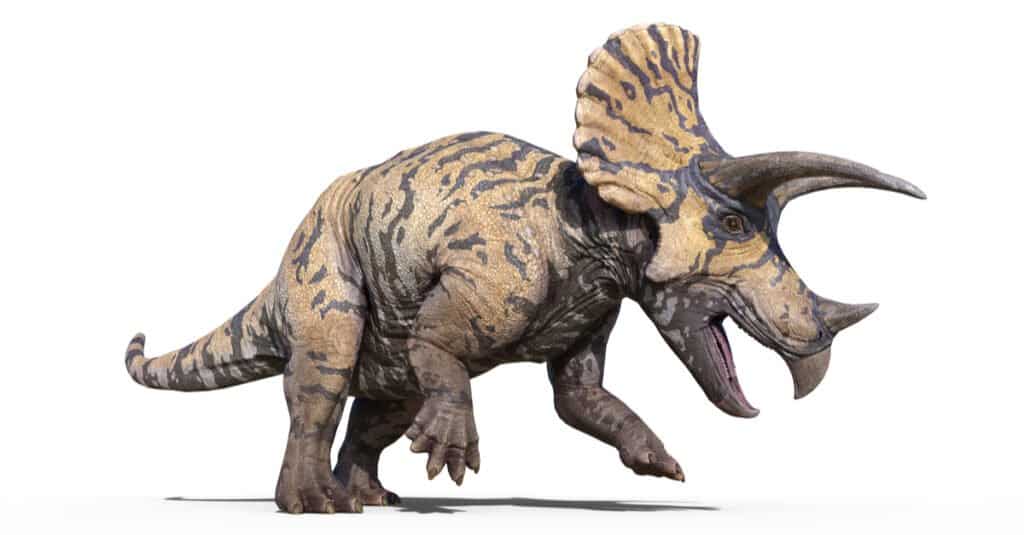
Rhinos look very similar to dinosaurs, especially the Triceratops. Have you ever seen replicas of dinosaurs at a museum or a zoo? They have leathery skin, broad legs and most had enormous bodies. If you were able to time warp a rhino back to prehistoric times you could imagine a rhino taking on a T-rex! But a Tyrannosaurus was 12-20 feet tall and would have no trouble fending off a 6-foot-tall rhino. Triceratopses are much bigger than rhinos as well, but are rhinos descendants of these horned dinos? Let’s find out!
Are rhinos related to dinosaurs like the Triceratops?

Triceratops were similar to rhinos in the sense they had horns, but the two animals are not related.
Triceratops and rhinos both have similar body structures, and both have horns on their head. Triceratops had three horns and were 30 feet long and weighed 12,000-16,000lbs. Rhinos have two horns (some have one) and are 12-13 feet long and the largest ones weigh between 3,000-7,500lbs. Triceratops were believed to be herbivores, consuming grasses, twigs, and fruit, and rhinos are also herbivores. So, it would seem that rhinos could be smaller relatives of these dinosaurs, however, this is untrue. Rhinos are not related to dinosaurs, even remotely. The biggest difference is that rhinos are mammals and dinosaurs are considered reptiles.
How are rhinos different than dinosaurs?

Rhinos are mammals so they have shared characteristics with other mammals like elephants, hippos, and horses. Although they are not covered in hair like a horse, they do have some hair which is a characteristic that all mammals share. They are also warm-blooded and have lungs for breathing air. Rhinos give birth to live young (usually one baby at a time every 2 ½ to 5 years) and their mother’s produce milk. The closest relatives to rhinos are called ‘odd-toed ungulates.’ Other members of odd-toed ungulates include horses, zebras, and tapirs (more on this below).
Dinosaurs are considered reptiles and like other reptiles are thought to have been covered with scaly skin (not hair), are cold-blooded, and lay eggs vs giving birth to their young. Reptiles also do not produce milk for their young. Triceratops had three horns and a frill of bone around the back of their skull. Fossils of Triceratops show that their horns could be 45 inches long. The first known Triceratops’s fossil found with the horn attached was found in Denver, CO in 1887. Researchers have studied these fossils and compared them to other fossils found in the U.S., Canada and Mexico. A unique feature of the Triceratops is that they have a beak-like mouth although they are not related to birds.
Who are rhinos related to?

Although you might think that rhinos are more similar to elephants or hippos the fact is their closest relatives are equids like tapirs, horses and zebras. They are in the same order as these animals, the order Perissodactyla. Rhinos are referred to as odd-toed ungulates. Where horses have hooves, rhinos and tapirs only have the front part of their foot covered with hooves and the rest of their foot is soft. Rhinos’ legs are thinner which leads to large round feet that have three large toes. Their body structure, although odd looking, supports a bdoy that can sometimes exceed 8,000lbs. Rhinos can even run with their feet and surprisingly, reach speeds up to 34mph!
Rhino vs Dino: Who would win in a fight?
If there was a fight between a Rhino and a Triceratops who do you think would win? Both could fight with their horns, the Triceratops could peck with its beak-like nose, both have thick tough skin. But the sheer size of the Triceratops would make it the clear winner.